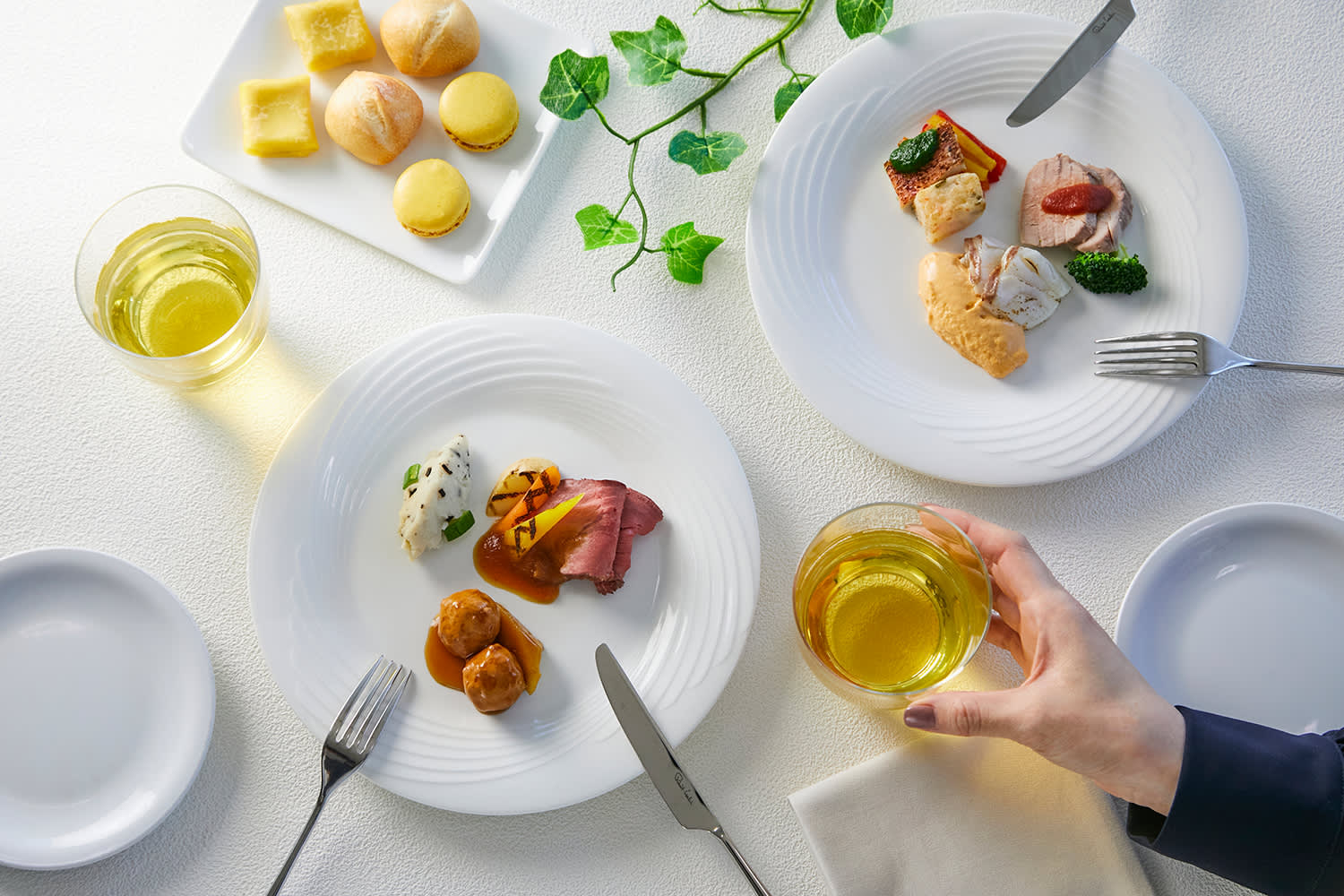Helping IBD patients with special recipes from Hyatt chefs | Takeda Stories

Offering IBD patients special recipes from Hyatt chefs
Think back to the last time you gathered with family or friends. The gathering probably centered around food. But for people who have inflammatory bowel disease (IBD), joining in those food-centered festivities can present a challenge. That’s because some people with IBD face dietary restrictions.

Deepening Understanding through a Disease Experience Program
To gain a deep understanding of the concerns of IBD patients, Hyatt Regency Tokyo staff participated in Takeda's "In Their Shoes" program, simulating the daily challenges faced by IBD patients, such as the sudden and urgent need to use the bathroom at work or face a dietary restriction at lunch.
Tomoko Kodama, Marketing Assistant Manager (at that time) at Hyatt Regency Tokyo, says, "The more I learned about IBD, the more I realized how much people can be restricted by their condition. This experience has motivated me to try to support patients through food, something that plays such an important role in our lives."
IBD, a condition characterized by inflammation of the digestive tract, may require dietary restrictions in some cases such as limiting fat, fiber, and spicy foods to avoid negative affects on symptoms1. With approximately 6.8 million IBD patients worldwide2, reducing symptoms to enhance quality of life is a common challenge.
“Party Plates to enjoy with IBD Patients”
So, Takeda and the Hyatt Regency Tokyo developed a range of home-delivery meals called "Party Plates with IBD Patients," carefully crafted with the guidance of a dietitian specializing in IBD.

"We realized that the restrictions faced by many IBD patients are more challenging than we initially thought, both physically and mentally. My aim was to infuse vibrancy and flavor into the food of IBD patients, enriching their lives through culinary experiences."
Shozo Okamoto, Head Chef, Hyatt Regency Tokyo
During the meticulous recipe development process, the team focused on selecting low-fat ingredients and also on enhancing flavor and presentation. The team carefully selected ingredients, utilized minimal oil, and employed slow, low-temperature cooking methods.

"Some dishes ended up being quite different from the initial vision. But through trial and error, we successfully created delicious meals that add diversity and color to the dining tables and lives of IBD patients."
Katsuaki Hoshino, Event Kitchen Chef, Hyatt Regency Tokyo
Sharing recipes and increasing disease awareness
Takeda’s Kazuhisa says some of these recipes are now available on a special website (and see below on this page), featuring preparation methods that are easy to do at home so that IBD patients can enjoy these dishes at their convenience.
Beyond recipe development, Takeda actively supports various disease awareness initiatives, including public talks and events, poster campaigns, and the creation of communication tools to raise awareness of IBD and the challenges that people with IBD face.
Kazuhisa emphasizes, "For over 240 years, our company has been focused on patients and helping to meet their needs. We will keep looking for innovative ways to help IBD patients live comfortably."
A selection of the menus and recipes for the Party Plates for IBD Patients, with modifications to make them easier to recreate at home, are given below.
Ingredients (Serves 1)
100 g beef thigh (inner thigh)
1/2 teaspoon grated ginger
1.5 teaspoons dark soy sauce
1 teaspoon mirin
1 teaspoon sake
4 g spring onion
18 g canned LaFrance apples or regular apples
20 g orange carrot cut into 2 cm slices
20 g yellow carrot cut into 2 cm slices
1/6 of an Irish cobbler potato
Cooking Instructions
Remove the fat and sinew from the block of beef thigh. Heat a non-stick frying pan, brown the surface of the meat, place it in a heatproof plastic bag, remove air and seal.
Pour boiling water into a rice cooker, add the beef in the bag to the water and place a plate on top to weigh it down. Heat in the keep-warm mode for 30 to 40 minutes. Key Points: If eating immediately, leave the meat at room temperature. If you wish to store it, first cool it down. For a hotel-like taste, boil at 58°C for 3 hours.
Chop up the canned LaFrance apples (minus the syrup) and spring onion.
Put the sake and mirin in a saucepan and bring to a boil to remove the alcohol, then add the spring onion, grated ginger, chopped LaFrance apples and soy sauce and heat until the mixture comes to a boil.
Add the mixture in (4) to a mixer and make the Japanese sauce.
Peel carrots, cut into 2 cm slices and microwave in a 600-watt microwave oven for 2.5 minutes. Wash the potatoes with the skin still on, cut into bite-sized pieces, immerse in water and microwave at 600w for 3 minutes. Key Points: Grill the potatoes for a hotel-cooked look.
Pour a little of the Japanese sauce into each dish, slice the beef thigh into thin strips, arrange on top, and garnish with the contents of (6).
Ingredients (Serves 1)
100 g Japanese pork fillet
60 g tomato puree
1/6 onion
A pinch of salt
A piece of broccoli
Cooking Instructions
Remove the fat and sinew from the pork fillet and cut into fist-sized pieces. Season with salt, put into a heatproof plastic bag and seal.
Heat the pork fillet in a hot water bath at 70°C for 1 hour then cool. Key Points: If eating immediately, leave the meat at room temperature. If you wish to store it, first cool it down. For a hotel-like taste, boil at 65°C for 3 hours.
Slice onion thinly and sauté in a pan with a little water (not included in the quantity) until the water evaporates.
Add tomato puree to the content of (3) and simmer to reduce the acidity a little.
Mix (4) with a blender to make the tomato sauce.
Wash the broccoli, cut into desired size, place in a heatproof container, cover with water and microwave at 600W for 2 minutes.
Cut the pork fillet into bite-sized pieces and serve with the sauce and broccoli.
Crohn’s & Colitis Foundation: https://www.crohnscolitisfoundation.org/diet-and-nutrition/special-ibd-diets
Alatab S, Sepanlou SG, Ikuta K, et al. The global, regional, and national burden of inflammatory bowel disease in 195 countries and territories, 1990–2017: a systematic analysis for the Global Burden of Disease Study 2017. Lancet Gastroenterol Hepatol. 2020;5(1):17-30. doi:10.1016/S2468-1253(19)30333-4
*Party Plates with IBD Patients is no longer for sale.
This article or its content are not meant to cure, prevent, diagnose, or treat any disease. Please seek advice from your healthcare provider for any health-related decision. The recipes and information provided are intended to be used as a guide only. Recipe results may vary from person to person. If you have any food allergies or sensitivities, please take care to review carefully the ingredients before consuming any foods. Takeda and Hyatt Regency Tokyo each disclaim any liability for any loss, damage, or claim of any kind (including without limitation liability for direct, indirect, incidental, or consequential damages) resulting from the utilization of the recipes or information found on this site.
Share this story


